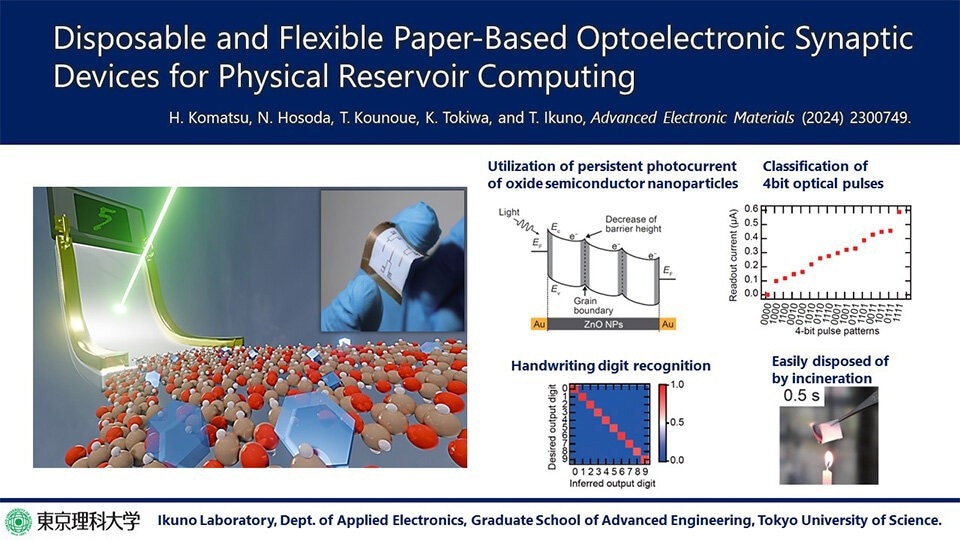
Image Credit: Tokyo University of Science
AI has a wide range of potential applications that could significantly impact society, including the creation of text, images, and self-driving vehicles. The cost of energy for all this capability is very high. For example, estimates show that more than 1,287 MWh, or 120 years' worth of electricity, were needed to train OPEN AI's well-known GPT-3 model.
This energy expenditure represents a significant obstacle, especially in deploying AI for extensive applications like health monitoring, where substantial volumes of vital health data are transmitted to centralized data centers for processing.
Apart from consuming significant energy, this approach raises concerns regarding sustainability, bandwidth overload, and communication delays.
AI-based biological diagnosis and health monitoring require a stand-alone sensor that can function without a continuous connection to a central server. Simultaneously, the sensor needs to have low power consumption for extended use, be able to process biological signals that change quickly for real-time monitoring, be flexible enough to attach to the human body comfortably, and be simple to make and discard because it needs to be changed frequently for hygienic reasons.
Tokyo University of Science (TUS) researchers, under the direction of Associate Professor Takashi Ikuno, have created a flexible paper-based sensor that functions similarly to the human brain by taking these factors into account. Their research was published online in the journal Advanced Electronic Materials.
A paper-based optoelectronic synaptic device composed of nanocellulose and ZnO was developed for realizing physical reservoir computing. This device exhibits synaptic behavior and cognitive tasks at a suitable timescale for health monitoring.
Dr. Takashi Ikuno, Associate Professor, Tokyo University of Science
Synapses allow information to move between neural networks in the human brain. Each neuron can process information independently, so the brain can manage several tasks simultaneously. Compared to conventional computing systems, the brain is far more efficient due to its capacity for parallel processing. To replicate this ability, the researchers created a photo-electronic artificial synapse device with gold electrodes on top of a transparent film with cellulose nanofibers (CNFs) and zinc oxide (ZnO) nanoparticles.
There are three primary uses for the transparent film. First, it lets light through, which means it can process optical input signals representing different biological data. Second, burning cellulose nanofibers makes them easily disposed of and adds flexibility. Thirdly, when exposed to a steady voltage and pulsed UV light, the ZnO nanoparticles become photoresponsive and produce a photocurrent. By simulating the responses that synapses in the human brain transmit, this photocurrent allows the device to process and interpret biological data received from optical sensors.
With a quick response time on the order of subseconds, the film could differentiate between 4-bit input optical pulses and produce discrete currents in response to time-series optical input. This prompt response is essential to identify abrupt alterations or anomalies in signals related to health. The electrical current response exhibited a greater amplitude for the second light pulse after exposure to two consecutive ones. This phenomenon, known as post-potentiation facilitation, improves synapses' capacity to recognize and react to familiar patterns and supports the brain's short-term memory functions.
To test this, the researchers converted the MNIST dataset of handwritten digits into 4-bit optical pulses. After applying these pulses of radiation to the film, they measured the current response. With 88 % accuracy, a neural network recognized handwritten numbers using this data as input.
This handwritten digit recognition ability was remarkably unaffected by up to 1,000 bends and stretches of the device, indicating its durability and suitability for frequent use.
This study highlights the potential of embedding semiconductor nanoparticles in flexible CNF films for use as flexible synaptic devices for PRC.
Dr. Takashi Ikuno, Associate Professor, Tokyo University of Science
Journal Reference:
Komatsu, H., et al. (2024) Disposable and Flexible Paper-Based Optoelectronic Synaptic Devices for Physical Reservoir Computing. Advanced Electronic Materials. doi.org/10.1002/aelm.202300749.